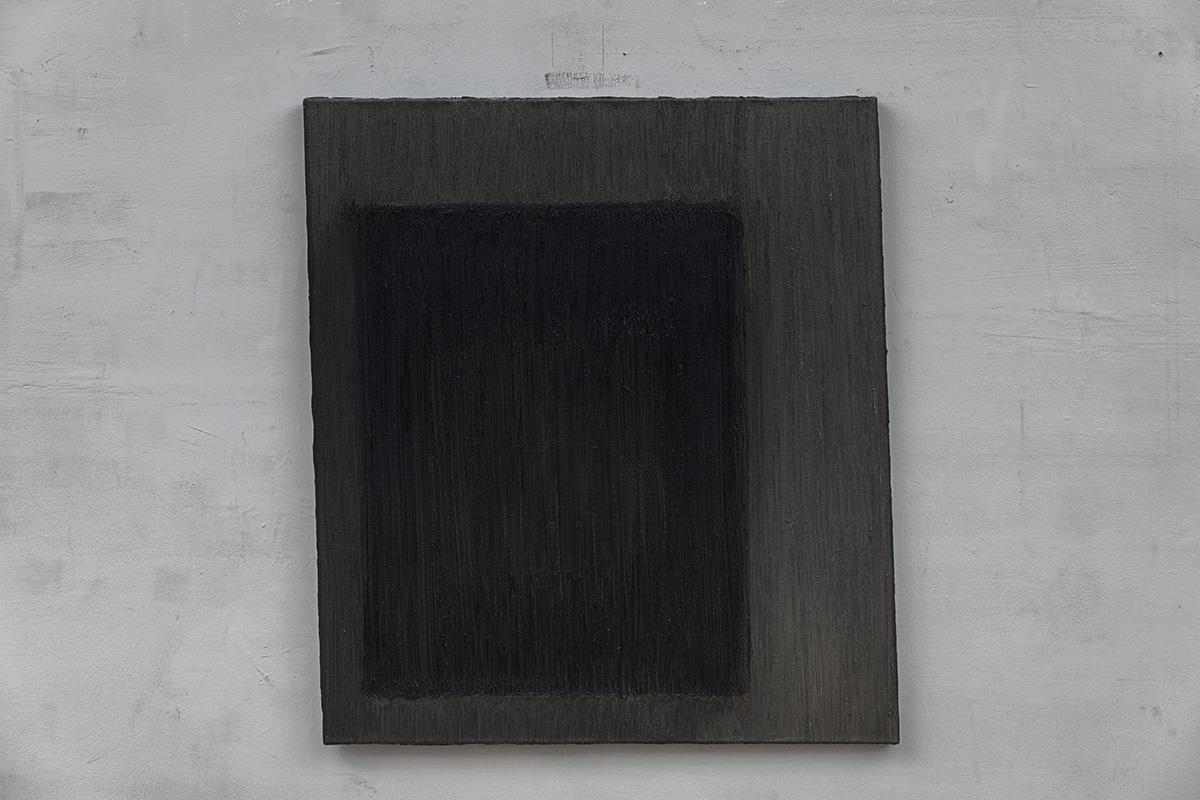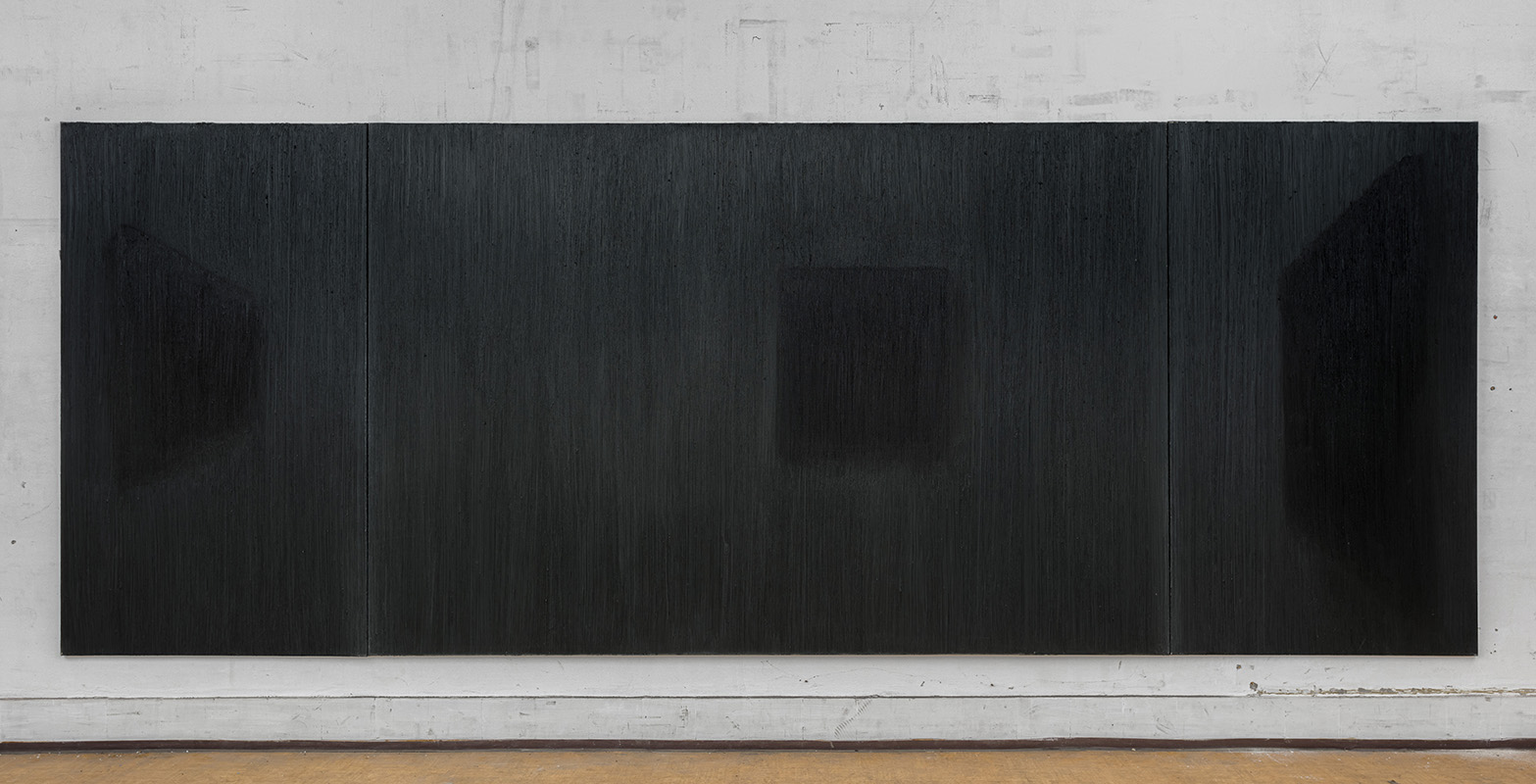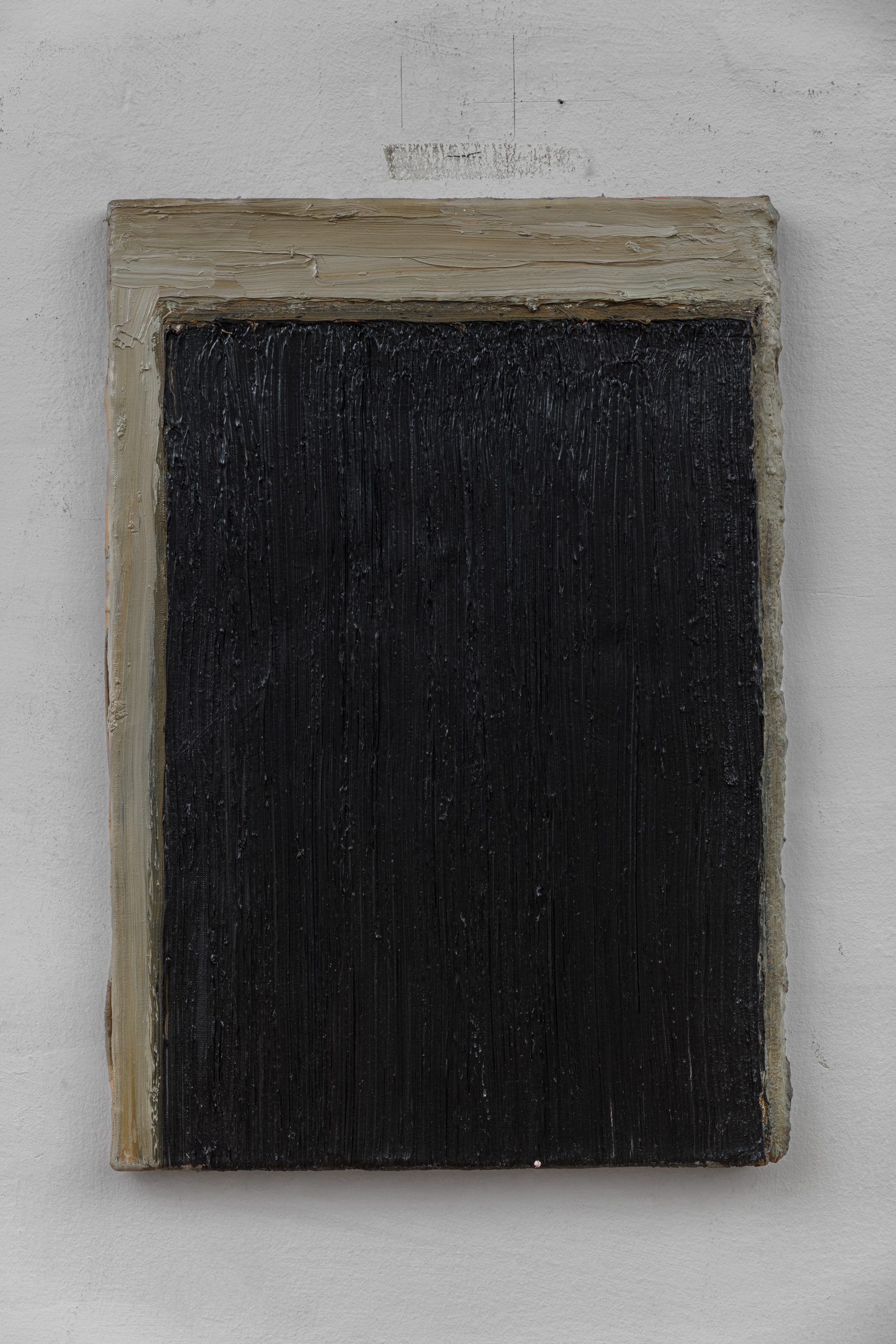Gábor Ősz: Pictures on the Wall
14 February – 6 April 2023
The internal radiation of dark looming pictures in a glimmering space. The light is inadequate for us to see what is impossible to see by daylight.
The isolation of light in the rooms of a museum reduces our glances into soft distraction. This is the recognition that follows from the hiding of the pictures: I imagine I am recognising. Where recognition appears, hiding must have taken place beforehand. Recognition means solution and comfort while hiding creates tension. Recognition and hiding – two conclusions operating actively together.
We do not have the opportunity here to analyse the pictures in a traditional way, but it does not seem to be necessary either. Failing to identify a picture exactly will result in a loss of history – the loss of the personal history of the painting. In the dim light the historic existence of the pictures is obscured, the role they play in art history becomes unclear. The entry of the painting into the dark is our attempt to win space.
I approach the picture as an object – as an indication of its existence. Thus the picture as an object and the painting made of it is a still-life. Space doubled this way becomes a painting in the painting. The picture depicts a picture, the picture identifies with the picture – it is about itself. The painting enters its own personal history.
However, this is not the simple formula of looking into a mirror. Here the picture is about what we see in it, that is, the receding light in the distance resembles a similar situation to a light beam appearing on the dark canvas, a glittering surface on a painting, or the gleam of rough paint surfaces.
Light itself is the relationship between a picture in a glimmering space and a camera, however the darkness of the pictures registers not intactness or the state of the apparatus one moment before operation, but a kind of dimming of illumination.
This lack of light is like a pencilled note on the margin – a possibility for those who can read between the lines, the essence, the place of hidden information. The message of the picture formulated once will be reinterpreted, redeveloped in the dark. Every painting has its own light, as it has its own innate darkness as well. The darkness of an overexposed film is interesting because it is a consequence of too much light. The ideal light hitting upon the idea. This is the photosynthesis of the picture.
I embrace centuries with my eyes in space reduced to a simple sentence. Suddenly the pictures have become my age. The common denominator of moment and whole in the given moment.
Gábor Ősz
(Published in: Gábor Ősz: Képek a falon / Pictures on the Wall. Exhibition catalogue, Szent István Király Múzeum, Székesfehérvár, 1991, 7.)

Vintage Galéria’s current exhibition presents pieces from Gábor Ősz’s series titled Pictures on the Wall created between 1992-1993. The pictures displaying borderline situations generated by the light and its absence in the space were based on Ősz’s childhood experiences. When visiting the dimly lit exhibition spaces of the Museum of Fine Arts in Budapest, Ősz noticed that due to the lighting conditions the pictures hanging on the walls were sometimes perceived reduced to dark squares. The artist also observed that paintings have a meaning even if the visual information they display cannot be clearly decoded by the viewer. From then on, Ősz began to deal with the ontological questions and the semantics of images, and with the matters of ‘the image of an image‘ and ‘the duplicated image‘. He recalled his memories in 1995 as follows: “When paintings became black squares they had a meaning that was contrary to information, yet they refer to everything related to the image; because darkness has the potential of infinity, rather than that of emptiness. The document of this idea became an image of an image, a picture of a picture: a duplicated space. The picture shows a picture; the picture is identified with the picture; the picture talks about itself.”[1]
Gábor Ősz graduated from the painting department of the Hungarian Academy of Fine Arts in 1986, then moved to Amsterdam in 1993. In the early 1990s, as part of his monochrome programme – influenced by, among others, Zsigmond Károlyi, who was a teacher at the Secondary School of Visual Arts and provided him writings and samizdats – Ősz started his Pictures on the Wall series, and exhibited the first pieces in 1990 at the Stúdió Galéria Budapest.[2] At that time, he painted on glass plates, behind which he placed reproductions of the works of Rembrandt and Master M. S., [3] as well as of the portrait of Francis II Rákóczi. Then he illuminated the sheets from behind with a lamp, incorporating the matters of illusionistic-representational painting and references in his work. The matter of references also comes into sight in case of the works exhibited at Vintage Galéria, as the work of other artists appears embedded in Ősz’s works, albeit unrecognizably. The artist discussed the motif as follows: “Hogarth used this device many times, of copying paintings by other artists and placing them within his paintings. It seems to me that this device of appropriating an image and overlaying it within another image is an underlying concept of image making.”[4]

Ősz exhibited pieces of the series painted on canvas in 1991 at the Szent István Király Múzeum in Székesfehérvár,[5] and then in 1992 presented an installative version at the Újlak Galéria in Budapest. In 1992, he continued his work at the Skidmore College in New York as part of an artist residency, and from 1993 he proceeded to work on the series at the postgraduate training at the Rijksakademie in Amsterdam. During his studies in the Netherlands, a lecturer introduced him to Allan McCollum’s Plaster Surrogates and Perpetual Photo series, which, at first glance, were close to the works of Gábor Ősz. But according to Ősz’s interpretation, McCollum was rather concerned with the mass appearance of objects and forms than with the conceptualized problem of the meaning of images. This realization encouraged him to start an extensive technical experimentation placing more and more emphasis on the conceptual nature of imagery during the creative process, and to include the possibilities of photography, film and video in the analytical artistic examination of the structure of the image.
In the case of Ősz’s paintings, the work of art, the information specially structured by the artist, begins to work by interacting with its recipient and creates tension. The image: the shown and hidden boundaries of visual information. Faced with an unknown phenomenon hidden in the visible, the viewer is forced to constantly rethink their associations, and in this mutual exchange the image becomes an object of art, and at the same time it casts light to the structure of the viewer’s perception. As Ősz states: “I found it interesting to observe how, by viewing the painting spectators can take part, in the formation of a new image. This seems to me to be a form of physical penetration into the painting. A meeting, a conversation between images.”[6] However, the seemingly paradoxical or tautological statement of the phenomenon as phenomenon, or the image as image, is actually an ambiguous statement, both an assertion and a denial. This ambiguity, the play with the viewer creates the working mechanism and dynamics of the image: in case of Ősz’s work, the visual information simultaneously affirms something and withdraws it, it is both a narrative and its elimination.

Within the Pictures on the Wall series, Ősz first painted the quasi-monochrome paintings with grandiose and expressive gestures using a sorghum broom as a brush, and then, during later visits to museums, he created the photographs – which are currently not exhibited –, for which’s creation light and its absence was also necessary, and which despite of being technical images also carry picturesque qualities. The paintings and photographs that seek the boundaries of the image simultaneously reveal the visual representation of Ősz’s questions and thoughts on the ontology and the semantics of images, and the direct image-making power of his painterly gestures. The paintings and photos elicited from pairs of opposites form an organic unity, they are based on the same intellectual-conceptual and yet sensual-visual approach, and represent the starting point of the artistic practice that Ősz continues to this day.
Although a radical technological and visual revolution has taken place in the field of art in the last 30 years, which in a certain way modified the artist’s former ideas and approach, as well as expanded his interest towards the mediums of film and video, but it did not radically change the way Ősz thinks about the nature of the images. His photographic works and videos explore the basic characteristics of the medium, his series titled The Colours of Black and White (2009) and Blow-Up (2010) he deals with the manipulation of space and the representational matters of the photographic image. In his later works entitled Ontology (2011) and Tautology (2012), the artist also works with the inadmissible visual information, so the early works of the Pictures on the Wall series also gain significance within Ősz’s latter artistic practice. Pieces of the series can be found in the collections of the Szent István Király Múzeum in Székesfehérvár and the Ludwig Museum – Museum of Contemporary Art in Budapest. Ősz’s other works can also be found in important public collections such as the Centre Pompidou (Paris) and the Stedelijk Museum (Amsterdam).
[1] Gábor Ősz: associations. Rijksakademie van Beeldende Kunst, Amsterdam, 1995.
[2] This text is based on Gábor Ősz’s own pronouncements which were stated in a conversation with Bernadett Grászli related to the exhibition titled Tabula Rasa (Godot Institute of Contemporary Art, Budapest, 15.01. – 15.04.2021.) Link.
[3] Éva Forgács: Gesztusok, hangulatvilágítással – Ősz Gábor képei a Stúdió Galériában. Magyar Napló, 15.11. 1990., 14.
[4] Ősz, 1995.
[5] Gábor Ősz: Képek a falon / Pictures on the Wall. Exhibition catalogue, Szent István Király Múzeum, Székesfehérvár, 1991.
[6] Ősz, 1995.













